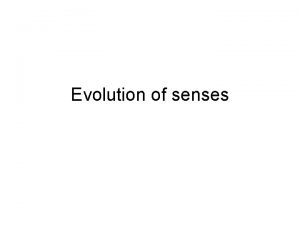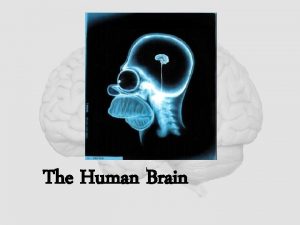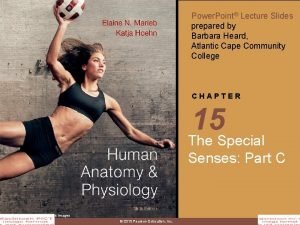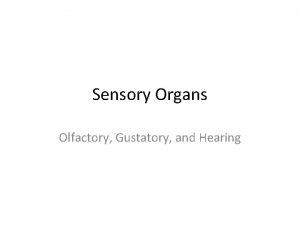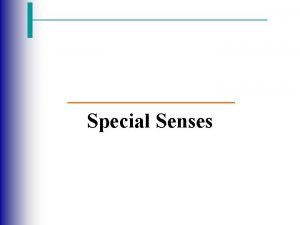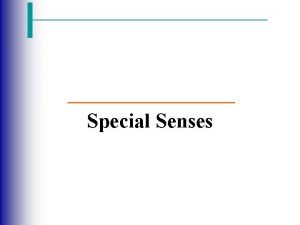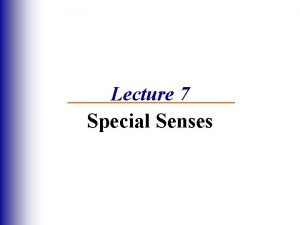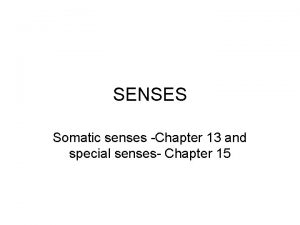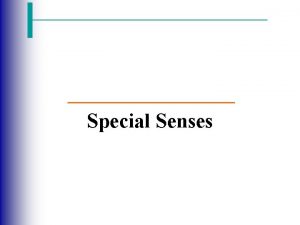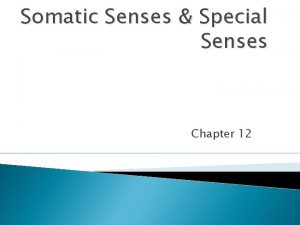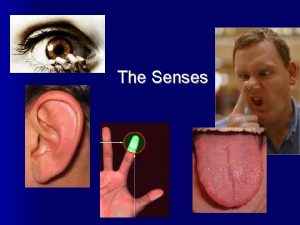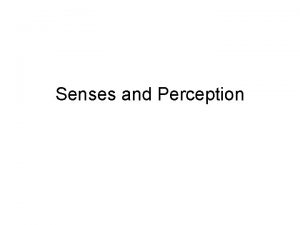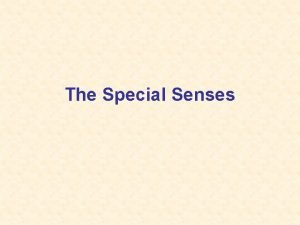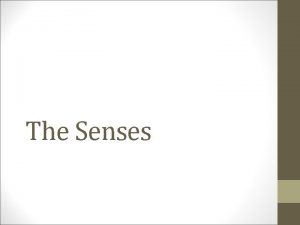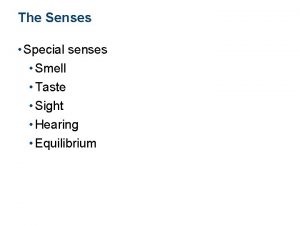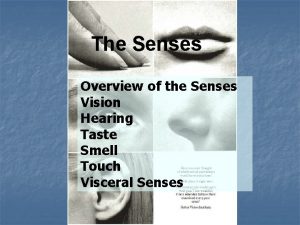The Senses Part 2 Gustatory Hearing Sense of


























- Slides: 26

The Senses Part 2 Gustatory Hearing

Sense of Taste (Gustatory) With what do we taste ? ? ? • Papillae = taste buds

Sense of Taste (Gustatory) Our five basic tastes: Imagine the taste of: 1. Sweet • Strawberries 2. Sour • Cheetos 3. Bitter • Bananas 4. Salty • French Fries 5. Umami • Chocolate

Umami A savory taste One of the 5 basic tastes Comes from the Japanese word umami meaning „pleasant savory taste“. Bacon, cheddar and beef all have umami, and together they “synergize the umami effect. ” Toss in sautéed mushrooms and you’ve struck an umami mother lode. Umami, he says, “alters our perception of other tastes, making salt, saltier, sweeter, and bitter and sour less biting. ” It is a taste that can’t be duplicated with any of the other four tastes.

Papillae The gustatory system uses chemoreceptors that allow our brain to interpret chemical compounds as specific tastes. The taste cells also called taste buds or Papillae are found in high concentration on the tongue. Each of the 5 tastes has their own papillae. Papillae react to different foods and send messages via neurons to the brain. Our brain interprets the message into a certain taste.

How does the Gustatory sense work? 1. Food enters the mouth and is broken down by the teeth as well as saliva. 2. Small food particles get caught in the taste pores of the tongue. If they are caught in the right papillae they stimulate the taste receptor cells. 3. The stimulated taste receptors cells send a nerve impulse down the neuron to the brain. 4. The brain interpret taste in the Parietal lobe in the same area smell is interpreted.

Why do smell and taste work together? Video clip • As we eat, odor particles enter our nose. • The smell is interpreted in the Parietal lobe and the brain is producing a feelling that matches the taste. • At the same time the taste buds (Papillae) are sending information to the same area in the brain and the brain interprets the taste. • Both smell and taste work together because they are processed together and the brain depends on both pieces of information to assess the situation correctly. Why can‘t we taste our food well when we have a cold?

Interesting facts about taste Spicy is not a basic taste because the sensation of spicy foods does not come from taste buds but rather from heat and pain receptors Your taste buds aren't just on your tongue; they're on the roof, cheeks and back of your mouth Taste perception fades with age; we lose almost half of our taste receptors by the time we turn 20! Flies and butterflies have taste organs on their feet, so they can taste anything they land on. Catfish have taste organs across their entire bodies. Eighty percent of what we experience as taste is actually smell. You can't taste what your saliva can't dissolve: Saliva dissolves the chemicals in food allowing the receptors on your taste buds to detect taste. Without it, obviously, food is tasteless.

It‘s Lab Day…. . Sensory Taste Materials: § Apples § Onions § Potatoes Let‘s mess with our sense of taste a little bit… Who will be your brave suspect? ?

The Sense of Hearing & Equilibrium EARS

Sense of Hearing External Ear Auricle: • outer ear External • Acoustic Meatus: Opening to the ear drum



Middle Ear Cavity Eardrum • A thin membrane Auditory bones: Malleus, Incus, Stapes • Transmit vibrations from enviroment and amplify the signal • Auditory tube Connects the middle ear to your throat • Helps maintain air pressure •


Inner Ear - Hearing Sense of Hearing Cochlea • Sense of hearing • Houses the hearing receptor cells Auditory • Nerve Sends nerve impulse from hearing cell receptors to the brain

Inner Ear Video clip …. . Video clip How does Hearing work? 1. Sound waves from enviroment get caught in Exernal Acoustic Meatus. 2. Sound waves travel down the External Acoustic Meatus and bump into the Eardrum. 3. The Eardrum moves the malleus, which moves the incus, which moves the stapes. 4. Stapes moves against the Cochlea. 5. The fluid in the Cochlea starts to move. Hair cells in Cochlea detect vibrations from middle ear as the fluid starts to move and stimulate hearing receptors. 6. Hearing receptors cells send nerve impulse down the Auditory Neve to the brain 7. Brain interprets in the tempral lobe what the sound wave means.


Hearing Test As you age, hair cells become damaged (loud music can speed this process along). Older people usually can’t hear frequencies that younger people can hear. Try the hearing test! How cochlear implants work. . Video clip 8 month old reacts to cochlear implant. . Video clip

Inner Ear - Equilibrium Sense of Equilibrium Semicircular Canals • Sense of equilibrium • Fluid filled Labyrinth • • channels fluid filled Connected to semicircular canals Vestibular • Nerve that sends impulse to brain

Inner Ear How does the sense of Equilibrium work? • Equilibrium is measured in two ways: 1. Fluid movement through semicircular Canals = directional movement of head (head tilting to shoulder, no motion, yes motion) 2. Otolith stones and hair cells = spead of movement

Equilibrium – Fluid in Semicircular canals Video clip 1. As we move our head the fluid in the semicircular canals begins to move. 2. This movement stimulates and bends a hair capsule to the left or to the right. 3. The receptor cells in the hair capsule send a nerve impulse through the Vestibular nerve to the brain. 4. The brain interprets the signal in the Cerebellum and lets us know in which direction we are moving.

Equilibrium – otolith stones and hair cells 1. As we move our head the fluid moves in the Labyrith channels. 2. The fluid moves the otolith stones which sit on top of hair receptor cells. 3. As the otolith stones are moved to one side, the hair receptor cells are stimulated and send a nerve impulse down the Vestibular nerve. 4. The Vestibular nerve sends the message to the cerebellum, which interprets the message and lets us know how fast we are moving.

Let‘s Label the Ear…. Crash Course Hearing & Balance

Let’s label… An ear Diagram + Research

 What is the difference between somatic and special senses
What is the difference between somatic and special senses General senses vs special senses
General senses vs special senses Narrow sense heritability vs broad sense heritability
Narrow sense heritability vs broad sense heritability Narrow sense heritability vs broad sense heritability
Narrow sense heritability vs broad sense heritability What is the gustatory system
What is the gustatory system Gustatory cells
Gustatory cells Sinners in the hand of an angry god imagery
Sinners in the hand of an angry god imagery Gustatory cells
Gustatory cells Where is the gustatory cortex located
Where is the gustatory cortex located Types of auditory hallucinations
Types of auditory hallucinations Which lobe is broca's area in
Which lobe is broca's area in Gustatory epithelial cells
Gustatory epithelial cells Thẻ vin
Thẻ vin Hát kết hợp bộ gõ cơ thể
Hát kết hợp bộ gõ cơ thể Thơ thất ngôn tứ tuyệt đường luật
Thơ thất ngôn tứ tuyệt đường luật Cái miệng bé xinh thế chỉ nói điều hay thôi
Cái miệng bé xinh thế chỉ nói điều hay thôi Các châu lục và đại dương trên thế giới
Các châu lục và đại dương trên thế giới Từ ngữ thể hiện lòng nhân hậu
Từ ngữ thể hiện lòng nhân hậu Diễn thế sinh thái là
Diễn thế sinh thái là Tư thế ngồi viết
Tư thế ngồi viết Thế nào là giọng cùng tên
Thế nào là giọng cùng tên Làm thế nào để 102-1=99
Làm thế nào để 102-1=99 Chúa sống lại
Chúa sống lại Hổ đẻ mỗi lứa mấy con
Hổ đẻ mỗi lứa mấy con Frameset trong html5
Frameset trong html5 đại từ thay thế
đại từ thay thế Quá trình desamine hóa có thể tạo ra
Quá trình desamine hóa có thể tạo ra







